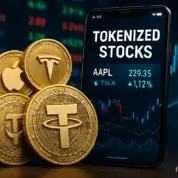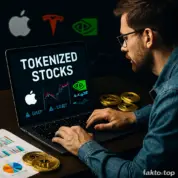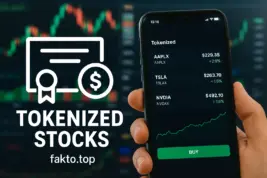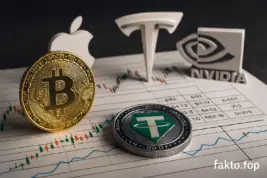Buy Tokenized Stocks with USDT
Tokenized Stocks Explained: Buy Apple, Tesla & More with USDT
Tokenized stocks are flipping the investment game on its head. Imagine buying Apple or Tesla shares without a broker, without fiat, and without Wall Street gatekeeping. That’s exactly what tokenized equities offer — fractional, blockchain-based versions of real-world stocks, tradable 24/7 with stablecoins like USDT.
Whether you’re a crypto native or just dipping your toes into DeFi, tokenized stocks let you diversify your portfolio with familiar names like AAPL, TSLA, and NVDA — all from your wallet. In this guide, we’ll break down how tokenized stocks work, where to trade them, and what you can realistically earn. No fluff, just facts, tables, and a bit of crypto swagger.

What Are Tokenized Stocks and How Do They Work?
Tokenized stocks are digital assets that mirror the price of traditional equities like Apple (AAPL), Tesla (TSLA), and Nvidia (NVDA). Each token represents a fraction or full share of a real stock, backed by custodians or synthetic mechanisms. These tokens are traded on crypto platforms and often pegged 1:1 to the underlying asset. Some platforms offer real backing via licensed brokers (like CM-Equity), while others use price feeds and derivatives. You don’t get voting rights, but you do get exposure — and sometimes dividends. The beauty? You can buy 0.01 of a Tesla share with USDT, no KYC, no market hours. It’s Wall Street, DeFi-style.
Where to Buy Tokenized Stocks with USDT
Several crypto exchanges offer tokenized stocks, each with its own twist. BingX leads the pack with xStocks like AAPLX and TSLAX — real-time trading, fractional shares, and even perpetuals. WhiteBIT supports tokenized assets via integrations with Backed Finance and other custodians. Tapbit offers spot trading of tokenized equities with clean UI and fast execution. Bybit leans into synthetic exposure via perpetual contracts — perfect for traders who want leverage and volatility.

Binance used to offer tokenized stocks but pulled back due to regulatory pressure, so it’s no longer a go-to for this niche. When choosing a platform, look for liquidity, transparency, and clear token mechanics. Some exchanges offer real asset backing, others use price feeds and synthetic derivatives.
Always check if the token is collateralized or synthetic — it affects both risk and reward. And yeah, don’t forget to test withdrawal limits and KYC policies before going all in.
| Token | Underlying Stock | Current Price | Dividend Yield | Available On |
|---|---|---|---|---|
| AAPLX | Apple Inc. | $229.35 | 0.48% | BingX, Tapbit |
| TSLAX | Tesla Inc. | $263.70 | 0% | BingX, Bybit |
| NVDAX | Nvidia Corp. | $492.10 | 0.03% | BingX, WhiteBIT |
How Much Can You Earn with Tokenized Stocks?
Let’s say you drop $50 USDT into AAPLX. At $229.35 per token, you’d get ~0.218 shares. If Apple pumps to $300, your stake becomes ~$65.40 — a 30% gain. Not bad for a fractional buy. Tesla’s more volatile: $50 gets you ~0.189 TSLAX. If TSLA moons to $350, you’re looking at ~$66.15. Dividends? Apple pays ~0.48% annually, so you’d earn ~$0.24/year on $50. It’s not passive income heaven, but it’s something. The real alpha is in price movement and DeFi utility — some platforms let you stake or collateralize tokenized stocks. Just remember: no voting rights, and synthetic tokens may carry platform risk.
| Exchange | Token Types | Trading Mode | Dividends | Referral |
|---|---|---|---|---|
| BingX | xStocks (AAPLX, TSLAX) | Spot & Perpetual | Yes (select tokens) | BingX |
| Tapbit | Tokenized Equities | Spot | Depends on issuer | Tapbit |
| WhiteBIT | Backed Assets | Spot | Limited | WhiteBIT |
FAQ: Tokenized Stocks for Beginners
Can I sell tokenized stocks anytime?
Yes, most platforms offer 24/7 trading. But liquidity varies — some tokens have tight spreads, others are ghost towns. Stick to high-volume assets like AAPLX or TSLAX for smoother exits. If you’re trading on DEXs, slippage can be brutal, so double-check before confirming. On centralized platforms like BingX or Tapbit, order books are deeper and execution is faster. Still, always test with small amounts first — especially if you’re new to tokenized equities.

Do I need KYC?
Depends on the exchange. BingX and Tapbit allow limited trading without full KYC, but withdrawals may be capped or delayed. WhiteBIT and Binance require verification for full access, especially if you’re moving large volumes. If privacy matters — choose wisely. Some platforms offer non-custodial options via wallets and DEXs, but those usually deal with synthetic tokens. For real asset-backed exposure, centralized platforms are still the main route — just be ready to flash your passport.
Can I use tokenized stocks in farming or staking?
Some platforms let you stake tokenized assets or use them as collateral in lending protocols. It’s early days, but DeFi integrations are growing. Imagine farming yield with Apple stock — welcome to 2025. Projects like Backed Finance and Ondo are pushing tokenized equities into lending pools, index vaults, and even NFT wrappers.
While not every exchange supports this yet, the trend is clear: tokenized stocks are becoming composable assets in the broader DeFi ecosystem. Just make sure the token you’re using is compatible with the protocol — synthetic versions may not qualify, and real-backed tokens might have lock-up periods or custodial restrictions.
Are tokenized stocks taxed like regular shares?
In most jurisdictions, yes — tokenized stocks are treated as taxable assets. If the token is backed by a real share, capital gains and dividend income may be subject to the same rules as traditional equities. In the U.S., for example, selling AAPLX for profit could trigger capital gains tax.
Synthetic tokens may fall under different categories, like derivatives or crypto assets, depending on local law. Always consult a tax advisor or use crypto tax software to track your trades. And don’t assume anonymity protects you — many exchanges report activity to regulators.
Can I build a portfolio with tokenized assets?
Absolutely. Tokenized stocks let you build a diversified portfolio using USDT or other stablecoins. You can mix Apple, Tesla, Nvidia, and even Coinbase — all in fractional amounts. Some platforms offer index-style bundles or vaults, while others let you DIY your allocation. The key is to balance volatility, dividend potential, and token mechanics. For example, AAPLX is stable and dividend-paying, while TSLAX is volatile but high-growth. You can also combine tokenized stocks with DeFi assets, NFTs, or stablecoin yield strategies. It’s TradFi meets crypto — and it’s all in your wallet.
What’s the difference between synthetic and backed tokens?
Backed tokens are tied to real shares held by a custodian — like CM-Equity or Backed Finance. They mirror the price of the underlying stock and may pay dividends. Synthetic tokens, on the other hand, use price feeds and smart contracts to simulate exposure. You don’t own the share — you’re trading a derivative. Backed tokens offer more transparency and legal clarity, but may require KYC and have limited DeFi utility. Synthetic tokens are flexible, fast, and often used in perpetuals or farming — but carry higher risk. Know what you’re buying before you click “Trade.”

Conclusion: Are Tokenized Stocks Worth It?
Tokenized stocks are quickly becoming a gateway for investors who want to bridge traditional markets and blockchain. By using USDT or other stablecoins, you can buy tokenized stocks with USDT like Apple (AAPLX), Tesla (TSLAX), or Nvidia (NVDAX) without relying on brokers or market hours. The ability to trade tokenized equities 24/7 directly from your wallet makes them a flexible alternative to standard shares, especially for crypto-native traders.
Still, investors should weigh the differences between asset-backed and synthetic tokens. Backed equities may include dividend payouts and real custodial backing, while synthetic tokens provide cheaper entry and DeFi utility but carry higher counterparty risk. Liquidity, transparency, and KYC policies vary by platform, so research carefully before committing funds. Choosing the best exchange for tokenized stocks means comparing spreads, withdrawal limits, and whether the token is collateralized or synthetic.
For beginners, the safest move is to start small: deposit USDT, test transactions, and gradually diversify with fractional tokenized shares. Exchanges like BingX, Tapbit, and WhiteBIT already support leading equities. With careful risk management, tokenized stocks can enhance your portfolio, giving you exposure to global companies and DeFi innovation at the same time.
Disclaimer: All brand names, logos, and trademarks such as Apple, Tesla, Nvidia, and others mentioned in this article are the property of their respective owners. Their inclusion is for informational and educational purposes only and does not imply any affiliation, endorsement, or partnership with fakto.top. This content is intended to explain tokenized stock mechanisms and does not constitute financial advice or investment solicitation.

